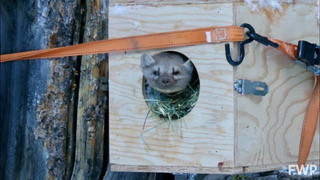Montana: FWP Begins Marten Restoration in Little Belt Mountains

FWP partners with trappers to capture marten in southwest Montana
Montana Fish, Wildlife & Parks and partners have begun an effort to restore marten to the Little Belt Mountains.
Marten, which are a member of the weasel family, were historically present in relatively isolated mountain ranges of central Montana, including the Little Belts, until they were extirpated within the last 100 years.
Because marten are generally unable to disperse naturally across large expanses non-forested habitat, FWP and partners developed a project to restore marten to the Little Belts. This involves capturing marten in parts of southwest Montana and relocating them to the Little Belts. However, the effort takes the help of many partners and FWP is collaborating with members of the Montana Trappers Association, Furbearers Unlimited, Fur Takers of America, the Great Falls and Southwest Montana chapters of Safari Club International, and the U.S. Forest Service to get the project done.
If successful, the project will restore a genetically diverse and self-sustaining marten population to one of the species’ native ranges in central Montana.
Marten reintroductions have a high success rate. A project to restore them to the neighboring Big Belt Mountains in 1956 proved successful with animals showing up on camera traps as recently as 2016.
FWP and the Montana Natural Heritage Program worked together to develop a predictive habitat suitability model for marten in Montana. That model indicated the Little Belts contain some of the highest-quality unoccupied marten habitat in the state. FWP reconfirmed final approval for a restoration project in the Little Belts from the Montana Fish and Wildlife Commission in August.
Volunteer trappers began working with FWP to capture marten in early December 2020, setting extensive trap lines in backcountry marten habitat. Marten are caught using live traps outfitted with an auxiliary wooden den shelter, allowing them to stay warm and to be transported safely. FWP biologists collect age, sex, and genetic information from the marten before releasing them.
Since the project began, 18 martens have been released in the Little Belts. By the end of February, biologists hope to have translocated at least 30 marten from the Beaverhead, West Pioneer, East Pioneer, Gallatin, Pintler, Flint Creek and Absaroka-Beartooth mountain ranges. Periodic supplemental translocations may take place in the coming years.
“The project wouldn’t be possible without the immense help of partners, who really have helped make this a reality,” said Bob Inman, FWP’s furbearer and carnivore coordinator. “Over time, we hope to see marten take hold in the Little Belts and thrive there once again. We appreciate the time and efforts of volunteer trappers, as well as the financial contributions of supporting groups.”





